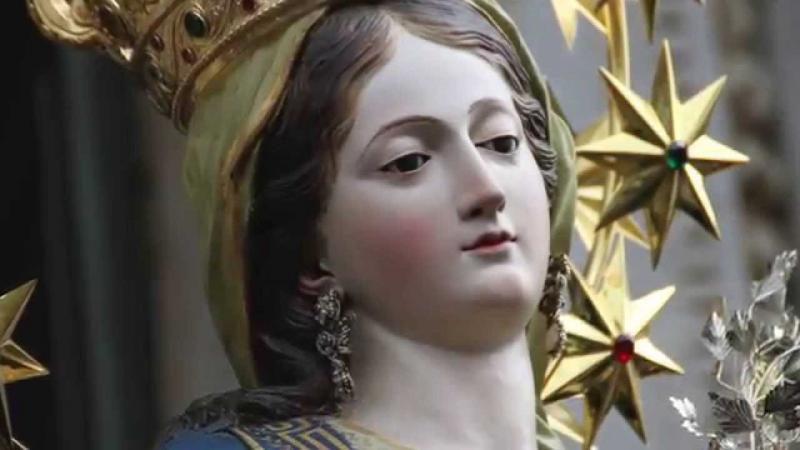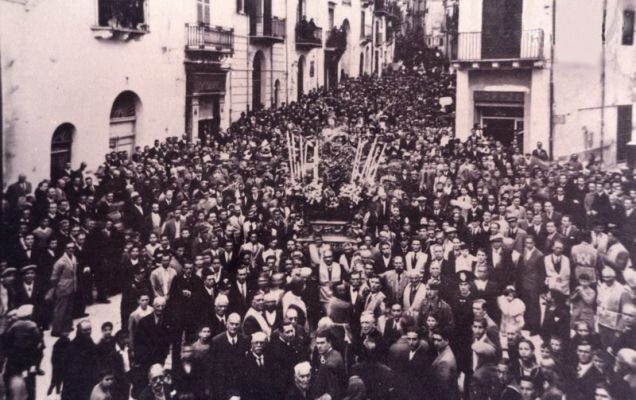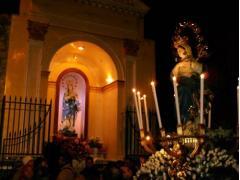Feast of the Immaculate Conception
Street View (if present)
Description
Feast of the Immaculate
----------------
Technical sheet prepared by: Region of Sicily - Department of cultural heritage and Sicilian identity - CRicd: Regional center for inventory, cataloging and documentation and Sicilian regional film library
N. Prog. 89
Well: Feast of the Immaculate Conception
Book: REI - Book of celebrations
Approval date: 13-04-2007
Category: Patronal feast
Province: Palermo
Municipality: Termini Imerese
Chronological News
The cult of the Immaculate Conception in Termini Imerese dates back to the seventeenth century, it was in 1623 that a grandiose baroque altar in stucco, wood and marble was erected in the Mother Church, positioned in the left transept on which the Immaculate Conception was depicted with her hands folded on her chest. The following year, in 1624, a solemn vow was made by the jurors of the city and by the devout people: a plaque, placed on the left wall next to the central door of the Cathedral, remembers the pact, or rather the guarantee that the termitans will always defend the Immaculate Conception of Mary.
The procession that still takes place at 4:00 in the morning is traditionally the most characteristic: before the arrival of the electric light (year 1905), the path of the nocturnal procession was illuminated by huge bundles, tied tightly and set on fire, of ampelodesma, 'ddisa, a fibrous plant that grows abundantly on the slopes of Mount S. Calogero.
In the vigil preceding the nocturnal procession, it was consumed 'to favazza, consisting of a leavened dough, placed in a large, previously oiled pan, covered abundantly with ripe tomatoes in pieces, onion, caciocavallo in pieces, salted anchovies, oregano and oil, prepared by housewives and cooked in the various city ovens. Today at the favazza numerous and succulent dishes and characteristic sweets are added.
Throughout the twentieth century, November 900 was considered an important day in which everyone gathered to crowd the Cathedral of Termini, on that date the solemn novenary took place in the afternoon, consisting of a long homily in which the priest, and often representatives of religious orders, they spoke of the greatness and graces that Mary dispenses. This tradition was established by Agostino La Nasa in 29, it was born as an occasion during which funds were collected for the celebration of the Immaculate Conception. The church for the occasion of the novenary was set up with long festoons of blue white color, fringed with gold, which fell along the columns of the central dome, other festoons decorated all the cornices and the preamble where the image of the Madonna was solemnly exposed under large and precious apparatuses.
Recurrence: Annual
Date: December 8th
Occasion: Celebrations in honor of the Immaculate Conception
Function: Devotional / Patronal
Actors: Members of the local clergy, carriers of fercolo belonging to the three brotherhoods of S. Francesco Saverio, of the Immaculate of the Maggior Chiesa and of the Immaculate of Porta Palermo, devotees.
Participants: Devotees, local community, tourists
Description: The Termitan people have always had a close link with the figure of the Immaculate Conception and her cult it is so deeply rooted that not only the termitan families but also the descendants of the emigrants still cultivate it today. The Immaculate Conception, in fact, is the main patroness of the city and it can be said that among the religious holidays she is the most heartfelt and awaited. In almost all the churches of Termini Imerese an image of the Madonna is venerated under this title and there are even three simulacra that are carried in procession on December 8th around the town.
The three city processions that traditionally take place are:
- on the morning of the 8th, starting at 4:00, the simulacrum of the Madonna della Neve, or Madonna di Notte, is conducted by the brotherhood of S. Francesco Saverio, from the Sanctuary of the Madonna della Consolazione, located in lower Termini, up to S. Salvatore Chapel in high Termini, which he enters around 8:30 am;
- at noon, from the Cathedral, located in high Termini, the brotherhood of the Immaculate Conception of the Greater Church, leads the simulacrum, created in 1799 by the sculptor Francesco Quattrocchi, up to the Church of Carmelo, in lower Termini, where it arrives around 14: 30;
- in the evening, starting at 19:00, the brotherhood of the Immaculate Conception of Porta Palermo conducts the simulacrum, placed in a chapel set in the ancient city wall near Porta Palermo, in lower Termini, up to the Church of S. Carlo, in upper Termini, ending its journey around 23 pm.
Eight days later the processions are repeated to bring the simulacra back to their respective churches of belonging. Particularly followed is the procession that brings the simulacrum back to the Duomo, in the square in front of the Chiesa del Carmine the faithful gather with large lighted torches in their hands waiting for the statue of the Immaculate Conception to come out, the long procession starts towards the upper Termini: via Vittorio Emanuele, take the monumental staircase of via Errante where the porters slowly manage to pick up the heavy fercolo and after the traditional run in via E. Setti Carraro and the fireworks display at the Belvedere, the simulacrum is closed inside the chapel to the Duomo.
During the paths of the processions traditional folk songs are performed that all the faithful sing with deep participation and intense spirituality, which is repeated by ancient tradition from generation to generation, a living faith that increases and enriches the soul of the termitans who turn to Virgin to protect them and grant them serenity.
The devotion sincere and profound for the Immaculate Conception can be found by observing the enormous participation of the crowd at the various processions and, above all, when the simulacrum of the Cathedral is extracted from the chapel where it is kept all year round.
REFERENCES
Catanzaro, Joseph. 1997. The party of the Immaculate Conception in Termini Imerese, the story of the solemn Novenary. Bagheria: printed by the Lions Club of Termini Imerese.
Catanzaro, Joseph. 2001. The party of the Immaculate Conception in Termini Imerese, the gold of the Madonna. Bagheria: printed by the Lions Club of Termini Imerese.
Come, Enzo. 2003. The cult of the Immaculate Conception in Termini Imerese: through the history of the Marian Confraternities. Termini Imerese: Creative.
Footnotes
During the feast this prayer written in the early 900s by the priest Tommaso Giunta (1882-1976) is recited:
At Mmaculata
Virgini bedda, Matri Mmaculata
the last ura of this bitter life
I vogghiu who was there cunsacrata,
pignu of trust and dear spiranza.
the last ura of this bitter life
I vogghiu who was there cunsacrata,
pignu of trust and dear spiranza.
Vui sites the patruna and the advucata
without defects and without naked tare,
save st'armuzza afflicted and scunsulata,
give me pirdunu cu sintenza clear.
without defects and without naked tare,
save st'armuzza afflicted and scunsulata,
give me pirdunu cu sintenza clear.
Save humanity, save us all,
lu poviru cunsola and the ignorant
and give us fruit from your love.
lu poviru cunsola and the ignorant
and give us fruit from your love.
Dintra lu celu, 'nsemmula a li santi
defeated and scattered the earthly waves,
Hurray! everyone will sing.
defeated and scattered the earthly waves,
Hurray! everyone will sing.
The valuable sculpture of the Immaculate Conception of Termini Imerese, in cypress wood, was created in 1799 by Francesco Quattrocchi from Palermo, based on the model of the silver statue of the Cathedral of Palermo. In 1888 the termitan painter Giuseppe Culotta completely repainted it. While in 1995, due to the precarious conditions of the simulacrum and the fercolo, the restoration was carried out.
In the past, following a rigorous decoration ritual, it was customary to wrap the entire mantle of the Madonna with precious precious objects offered by the faithful; now these gifts, which over the years have reached a considerable quantity and a considerable economic and historical-artistic value, are kept in the Maggior Chiesa and are exhibited only for particular occasions under careful supervision.
In 2004 an exhibition on the Immaculate Conception was carried out in the Basilica of San Francesco d'Assisi in Palermo: there the statue was considered as the supreme work created by Francesco Quattrocchi.
Author Profile: Maria Rosaria Paterno '
Go to Google Maps
Send a notice to the publisher
[contact-form-7 id="18385"]







